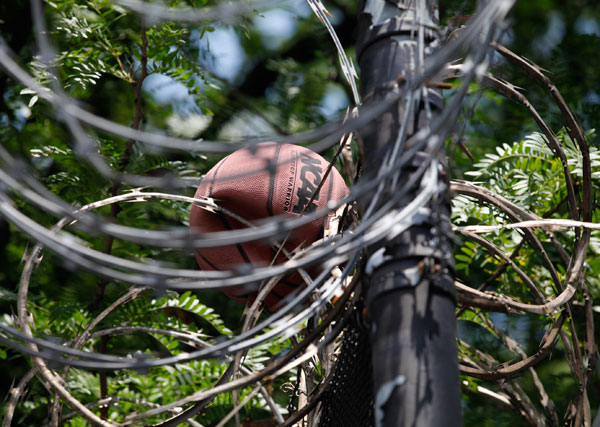
Photo by: Marc Fader
Barbed wire at Bridges Juvenile Facility in the Bronx traps a basketball.
At New York City’s three juvenile justice facilities, a few hundred teenagers sleep in locked buildings fenced behind barbed wire. They wear uniforms and have their movements monitored, as if they were in jail.
Many go into the facilities frightened and come out tough. Most aren’t accused of violence, having been caught writing graffiti, jumping turnstiles or shoplifting. And none of them have been convicted of the allegations they currently face.
Now the city plans to reform this system, partly by putting more troubled kids into community-based programs and counseling. Only those deemed truly dangerous will be subject to pre-trial detention.
Ultimately DJJ and ACS plan to close Bridges Juvenile Center, a secure facility in the Bronx, where approximately 130 young people are held. The thinking is simple: treat youthful offenders like kids in trouble, not junior criminals.
“Community placements allow us to save money and are better for the kids,” said Laurence Busching, executive deputy commissioner of the division of youth and family justice at the Administration for Children’s Services, in an interview. “For the kids who can safely be managed in the community, we want to do that,” he said.
Such youth could be placed in after school and summer recreational programs, or into community monitoring, which involves intensive supervision by the department of probation, and often curfews and nightly check-ins. Busching added that being locked up is traumatizing, weakens family and community ties, disrupts school and often exposes young people who are accused of minor crimes to more serious offenders.
The coming reforms, led by the city’s Department of Juvenile Justice and its Administration for Child Welfare, generally have the support of the chair of the City Council’s committee on juvenile justice, Councilmember Sara Gonzalez. At an oversight hearing held late last month to discuss the agencies’ plan, Gonzalez expressed that support.
Avery Irons, director of Youth Justice Programs for Children’s Defense Fund- NY praised ACS and DJJ for adopting progressive, child-centered reforms. But she voiced frustration about the pace of the city’s progress toward closing Bridges, a move that has been under consideration since 1978. “There are not that many kids in there,” she said. “If they are really committed to closing it, they can get them reassigned quickly. We need to make sure this actually happens.”
The Department of Juvenile Justice introduced its plan and benchmarks to measure its progress in June, but the intended reforms began about a year ago and have already reduced the number of youth sent to Bridges or to its partner facilities, Horizon and Cross Roads, testified ACS’ Commissioner John Mattingly, at last month’s hearing. Some of the juvenile offenders are being diverted to a “continuum of community-based alternatives-to-detention and placements for juveniles” that Mattingly said ACS helped establish.
ACS and DJJ intend to close Bridges by this fall, Busching said. But to reach that goal – and to divert more offenders from secure detention to community-based programs – more community-based programs must be created or existing ones must be expanded. A new alternative to detention program operated by NY Foundling is due to open next month on Staten Island, Busching said. But each borough can currently only accommodate an average of 40 alternative to detention positions, Busching testified.
At the hearing, ACS also pleaded, to no avail, for the council to approve the merger of DJJ and ACS before adopting the 2011 city budget. The move, announced in Bloomberg’s State of the City address in January, is intended to save money and emphasize the youth services elements of the juvenile justice system.
The two agencies have been operating in concert since March. However they still have separate budgets and jerry-rigged purchasing and personnel functions.
A bill that would formally merge the agencies was introduced in late April. The matter could be scheduled for discussion and action in August, said Miquel Hernandez, legislative director for Councilmember Sara Gonzalez.








